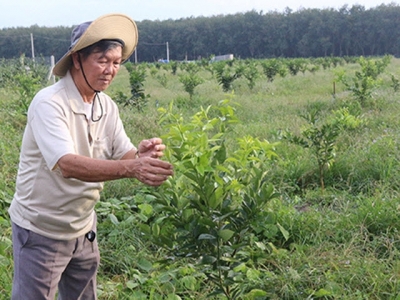Supply-demand linkage for consumption of agricultural product promoted

At a conference making the likage between supply-demand for consumption of agricultural products just held by Bau Bang district’s People’s Committee, provincial Department of Industry-Commerce and Department of Agriculture and Rural Development, participating delegates, including representatives of concerned agencies, farmsteads owners and businesses in the province, discussed measures to create a value chain from production to consumption.
Mai Ba Tho and his green-skin pomelo farmstead in Bau Bang district’s Tru Van Tho commune
Boosting linkage
With its abundant land fund plus favorable climate conditions, Bau Bang district has focused on developing hi-quality specialized areas for agricultural production. The whole district has to date had a total of 397.3 hectares of fruit trees, including 296.6 hectares of citrus fruit trees and more than 21 hectares with cultivation under VietGap standards, mainly in Long Nguyen, Tru Van Tho, Lai Uyen and Cay Truong II communes.
Le Thanh Tam, Vice-Chairman of Bau Bang district’s People’s Committee said that there are now a lot of preferential policies to promote farmsteads from the State. The district aims at hi-tech agricultural models and there are such models developed with high economic efficiency. The district has boosted the linkage between supply and demand for stability in consumption of agricultural products.
The district is implementing a variety of pilot cultivation models. Under the support of relevant agencies, the district is proactive to call for farming households to get involved in the local pilot programs on growing clean vegetables and other agricultural products.
Periodically, the district has also organized trips to hi-tech agricultural models in and out of the province, helping farmstead owners, businesses study and apply new techniques into production for better development.
Linkage is indispensable
At the conference, representatives of province-based Co.op Mart, Citi Mart and Lotte Mart obviously mentioned their requirements when purchasing agricultural products.
Farmers in the district have also deliberated coherence methods in terms of technology and output at businesses’ requirements. They also want to have more support policies on science-technology in order to reach higher productivity and quality while being assisted for stable consumption.
In the coming time, businesses need to have close coordination, be proactive in building prestigious Vietnamese trademarks. Businesses and farmstead owners also need to continue being flexible in getting access to modern technologies at the process of producing, supplying products with high value.
Nguyen Thanh Ha, Vice-Director of provincial Department of Industry and Commerce said that the linkage between supply-demand of commodities is one of concrete and practical actions in supporting businesses to develop and expand production with stable consumption in accordance with the province’s orientation.
In the coming time, localities need to be proactive to promote the linkage based on cooperation between relevant sectors and departments with contents making supply-demand orientations, guiding farming households to apply certificated standards like ISO, VietGAP, GlobalGAP…They also need to replicate linkage models in production and consumption towards improving the quality of products and ensuring food safety-hygiene. Meanwhile, provincial Department of Industry and Commerce will support the local consumption of agricultural products into province-based enterprises’ distribution system at a maximum level to meet people’s consumer demand, create a stable consumption market for farmers and help businesses reach sustainable development.
Related news
 Vietnam gearing up for upcoming lychee and longan harvests
Vietnam gearing up for upcoming lychee and longan harvests Bac Giang and Hai Duong provinces are projected to produce 150,000 tonnes and 55,000 tonnes of lychees respectively, while the longan yield of Hung Yen province
 Is $40 billion worth of farm exports beyond reach?
Is $40 billion worth of farm exports beyond reach? The high agricultural production growth rate in Q1 2018 has prompted government to set a target of exporting $40 billion worth of farm produce this year
 Vietnam rice rates up for fifth week; currency moves weigh on India, Thailand
Vietnam rice rates up for fifth week; currency moves weigh on India, Thailand Demand is high and supplies are low as the Philippines might buy more rice for the rest of the year.